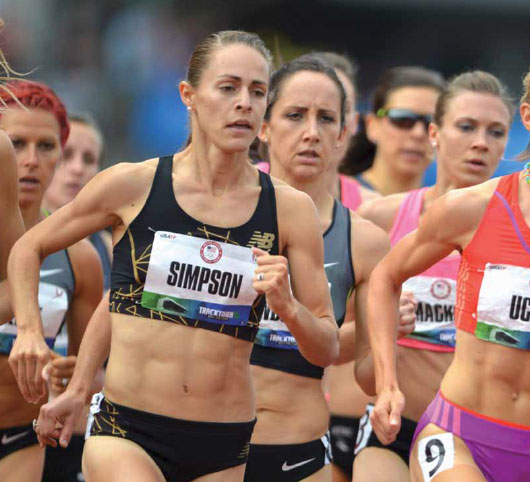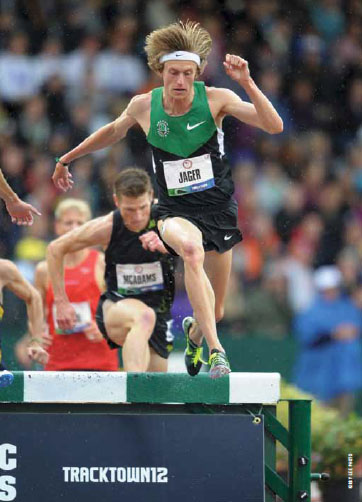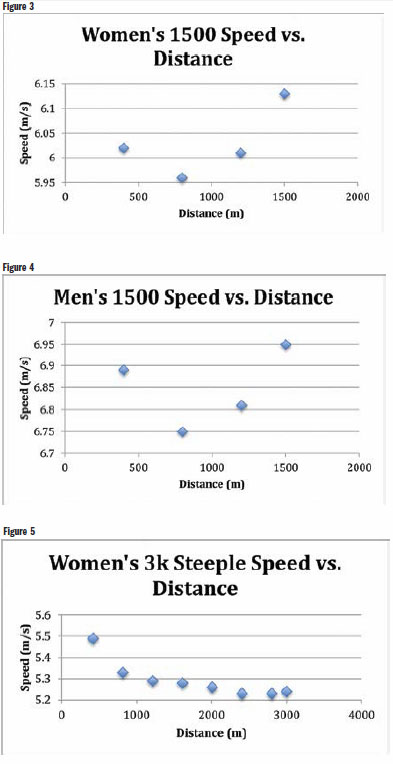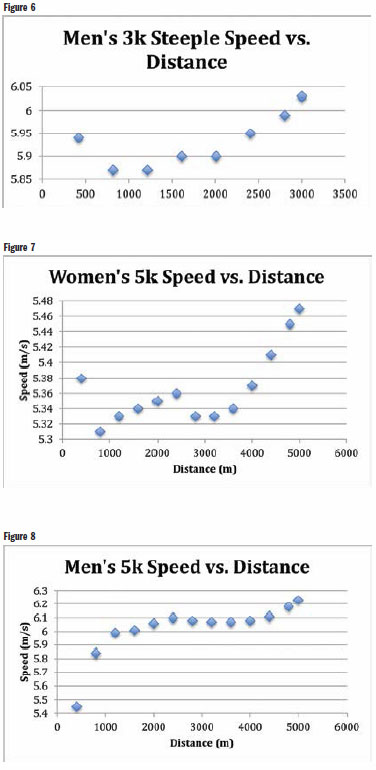|
Pacing Strategies for Distance Events Originally Published in Techniques Magazine - The official publication of U.S. Track & Field and Cross Country Coaches Association - USTFCCCA

Thiel et al. (2012) claim that, "pacing strategy is an important determinant of success in sports competitions. Athletes have to distribute their ability to provide for muscular adenosine triphosphate (ATP) generation while maintaining an adequate reserve such that the athlete never runs out of energy and faces catastrophic physiological failure before the finish, nor has excess energetic reserves at the end of the competition." Foster et al. (2009) claim that pacing strategies are based on extensive experience gained during training and previous competitions. Tucker et al. (2006) state that the "best race" strategy in the 800 meters is small but progressive slowing. In the 1500- to 10,000-meter track races, the "best race" strategy has been described as even pacing with an endspurt (Tucker et al., 2006). In championship races, since finishing place is a more important outcome than finishing time, the top runners might run with a slower pace with varied tactics, and variations in pace can vary with the overall pace of the race (Thiel et al., 2012). Since the U.S. Olympic trials is a championship race, but there are also Olympic standards that have to be met, the pacing strategies may be slightly different than typical championship races. Thiel et al. (2012) have found that lap splits in world record performances suggest smooth and slow transitions of speed. However, in Olympic finals races, Thiel et al. (2012) found "microvariation" was seen and likely represents the complex regulation necessary to balance runners' efforts to keep their pace at the desired level despite growing fatigue, while avoiding a physiologically catastrophic event. Thiel et al. (2012) describe three different winning strategies used in distance races: a continuously high speed throughout the race, a "break away" in the middle of the event by increasing the pace, or a long endspurt after a gradual increase in speed at the end of the race (Thiel et al., 2012). In short duration events (< 4 minutes), the typical pacing strategy involves a fast start, with power output declining progressively until completion (Tucker & Noakes, 2009). Tucker and Noakes (2009) found that in an 800-meter event, the typical pacing strategy involves a fast first lap, with a significant decrease in speed on the second lap. This type of pacing strategy was seen in both the women's and men's 800-meter races at the U.S. Olympic trials. Interestingly, in the women's 800-meter race, many of the women competing in the final already had the Olympic "automatic" qualifier before the finals. Therefore, many of the women were racing in order to place in the top three, not necessarily for time. Alysia Montano, Geena Gall, and Alice Schmidt finished 1-3 in the finals and qualified for the U.S. team at the London Figure 1: Speed vs. distance of the winner of the women's 800-meter final at the U.S. Olympic trials. The winner positive split the second half of the race. In the men's 800-meter race, the competitors employed the typical positive splitting pacing strategy. The top three finishers all had the "automatic" Olympic standard before the race and ran faster than the standard during the race. Nicholas Symmonds, Khadevis Robinson, and Duane Solomon Jr. finished 1-3 and each qualified for the London Olympics. Figure 2: Speed vs. distance of the winner of the men's 800-meter final at the U.S. Olympic trials. The winner positive split the second half of the race.
In the men's 1500-meter race, only six competitors had the Olympic "automatic" standard going into the finals. Therefore, the pace went out fairly fast in the beginning, because some of the athletes without the "automatic" standard wanted to try to finish in the top three and hit the standard. However, as is typical in many championship 1500-meter races, the pace slowed during the middle and the fastest lap of the race was the final lap. Leonel Manzano, Matthew Centrowitz, and Andrew Wheating finished 1-3 and qualified for the U.S. team at the London Olympics. Figure 4: Speed vs. distance of the winner of the men's 1500-meter final at the U.S. Olympic trials. The winner negative split the second half of the race. The 3000-meter steeplechase is a particularly difficult race since the competitors not only have to race 3000m, but they also have to jump over barriers and a water jump. Therefore, strength and energy conservation are critical for success in this race. Tucker and Noakes (2009) state that, "substrate availability is often implicated as a limiting factor during exercise performance. Volitional fatigue during exercise at a constant workload is often thought to coincide with muscle or liver glycogen depletion." Pacing is important in a difficult distance race such as the 3000-meter steeplechase in order to prevent catastrophic fatigue. In the women's 3-kilometer steeplechase, the top three finishers all hit the Olympic "automatic" standard during the finals. The pacing of the leader during in the women's 3-kilometer steeplechase started out fast and slowed down as the race progressed. The third place finisher, Shalaya Kipp, did not have the Olympic "automatic" standard going into the finals. However, since she hit the Olympic "automatic" standard in the final and finish third, she secured her trip to the London Olympics. Figure 5: Speed vs. distance of the winner of the women's 3000-meter steeplechase final at the U.S. Olympic trials. The winner positive split the second half of the race Unlike the women's 3-kilometer steeplechase, the men's 3-kilometer steep negative split the second half of the race. Many of the men in the final already had the Olympic "automatic" standard going into the U.S. Olympic trials. Therefore, the race was more tactical, and many of the competitors were running for place and to conserve energy rather than run a fast race. Evan Jager, Donald Cabral, and Kyle Alcorn finished 1-3, all running the Olympic "automatic" standard in the finals (which they all had prior to the race) in order to qualify them for the London Olympics.
In the women's 5-kilometer race, many of the top contenders had the Olympic "automatic" standard going into the finals. The race began as a fairly tactical race, but with approximately 1 kilometer to go, Julia Lucas, who already had the Olympic "automatic" standard, started to increase the pace. Tucker and Noakes (2008) claim that exercise work rate typically increases significantly at the end of longer duration exercise bouts. However, in the case of Lucas, she started to increase her work rate too early in the race and ended up having a 'catastrophic' event in the last 400m of the race. She got passed by the top two finishers, and then at the very end was beaten out by Kim Conley, who finished third and ran a time under the Olympic "automatic" standard (which she didn't have prior to the 5-kilometer finals). Therefore, the U.S. Olympic team for the women's 5-kilometer was Julie Gulley, Molly Huddle, and Kim Conley, with Julia Lucas barely missing out on qualifying for the Olympic team. Figure 7: Speed vs. distance of the winner of the women's 5000-meter final at the U.S. Olympic trials. The winner negative split the second half of the race. In the men's 5-kilometer race, Bernard Lagat, Galen Rupp, and Lopez Lomong were the favorites, and each of them had the Olympic "automatic" standard prior to the finals of the 5-kilometer. Therefore, the pacing strategy of this race was similar to many championship races, such that the race started out at a slower race and then increased over time, with the last lap as the fastest lap of the entire race. Galen Rupp outkicked Bernard Lagat to win the 5-kilometer, followed by Lopez Lomong. All three qualified for the London Olympics. Figure 8: Speed vs. distance of the winner of the men's 5000-meter final at the U.S. Olympic trials. The winner negative split the second half of the race. When competing in a race, long endurance races such as the 10 kilometers, appropriate distribution of energetic resources is critical. Billat et al. (2006) compared subjects who raced a 10-kilometer event at a free pace throughout versus subjects who raced at a constant-pace. The results of their study showed that the larger degree of pace variation in the free paced races may be a strategy to minimize the physiological strain during severe exercise and prevent premature termination of effort (Billat et al., 2006). At the 2012 U.S. Olympic trials, the winner of the women's 10 kilometers ran at varying speeds throughout the race (Figure 9). However, as the race progressed, the speed was increased, such that the second half of the race was faster than the first half. This strategy was likely employed to ensure that a 'catastrophic' event, where there is a significant decrease in pace for an athlete due to exhaustion, did not occur during the race. In the end, Amy Hastings outkicked collegian Natosha Rogers and Olympic bronze medalist Shalane Flanagan to win the race. Since Rogers did not already have the Olympic "automatic" standard and did not eclipse that standard in this race, the fourth place finisher, Lisa Uhl (who had the "automatic" Olympic standard) qualified for the London Olympics, along with Hastings and Flanagan (USATF, 2012).
 The pacing strategies of the distance races at the U.S. Olympic trials were similar to many championship races. The men's and women's 800-second positive split, which is typical for running events of a shorter duration. The other distance races an negative split, meaning that the pace of the race picked up in the second half, which is typical for longer distance events in championship races. This strategy enables many of the top competitors to conserve their energy for the end of the race when they need to sprint at the finish. These athletes needed to ensure that they finished in the top three in order to secure a spot on the U.S. Olympic team at the London Olympics. The only exception to this pacing strategy was the women's 3000m steeplechase, where the competitors positive split the second half of the race. Since few competitors in this race had the Olympic "automatic" standard, it is likely that the race started faster to ensure the race was run at a pace that would enable competitors who did not yet have the Olympic "automatic" standard to try to achieve it and finish in the top three. Therefore, the fact that the competitors had to be the top three finishers with the Olympic "automatic" standard did influence the pacing strategies in some of the distances at the U.S. Olympic Trials.
 |
|
|





 Olympics.
Olympics. Figure 3: Speed vs. distance of the winner of the women's 1500-meter final at the U.S. Olympic trials. The winner negative split the second half of the race.
Figure 3: Speed vs. distance of the winner of the women's 1500-meter final at the U.S. Olympic trials. The winner negative split the second half of the race. Figure 6: Speed vs. distance of the winner of the men's 3000-meter steeplechase final at the U.S. Olympic trials. The winner negative split the second half of the race.
Figure 6: Speed vs. distance of the winner of the men's 3000-meter steeplechase final at the U.S. Olympic trials. The winner negative split the second half of the race. Figure 9: Speed vs. distance of the winner of the women's 10,000-meters final at the U.S. Olympic trials. The winner negative split the second half of the race.
Figure 9: Speed vs. distance of the winner of the women's 10,000-meters final at the U.S. Olympic trials. The winner negative split the second half of the race.


